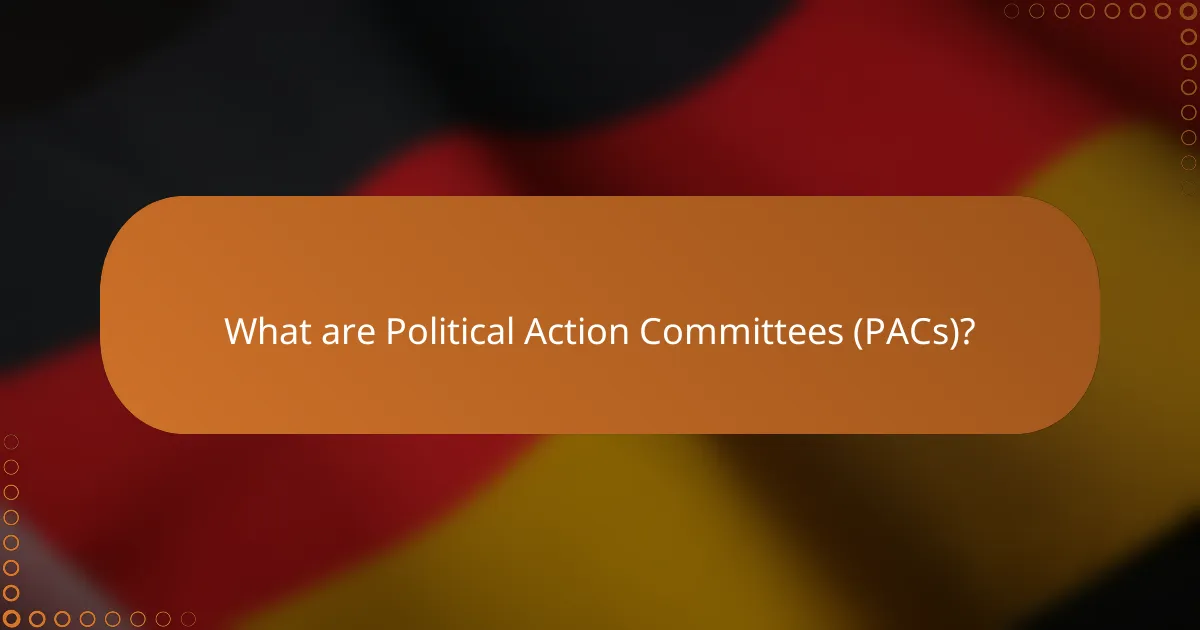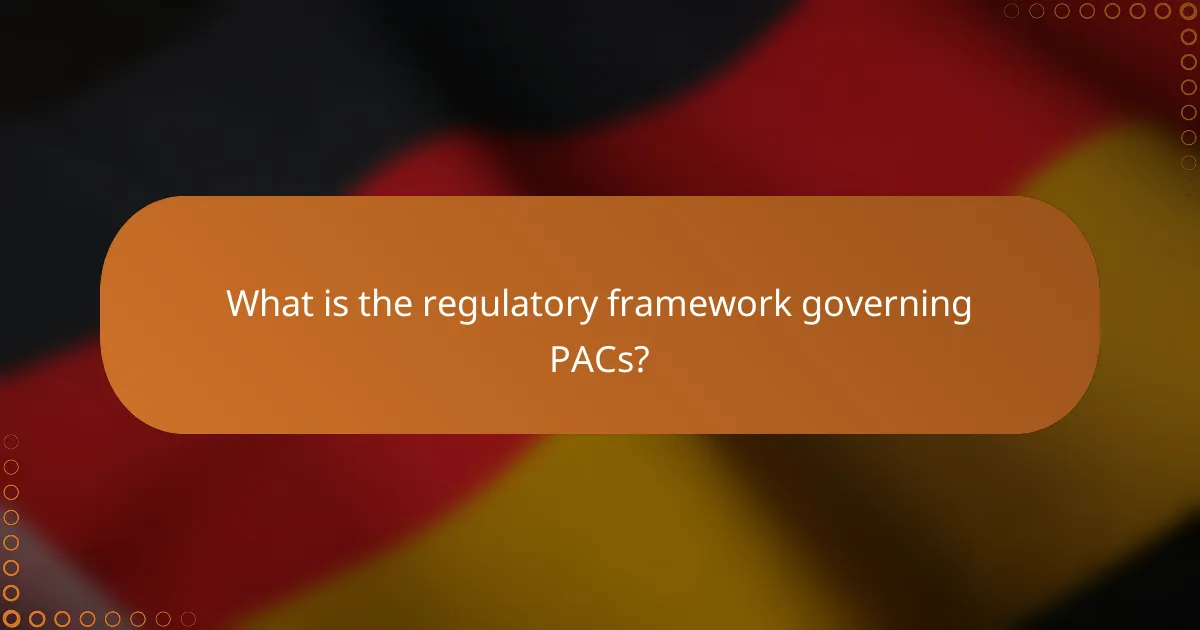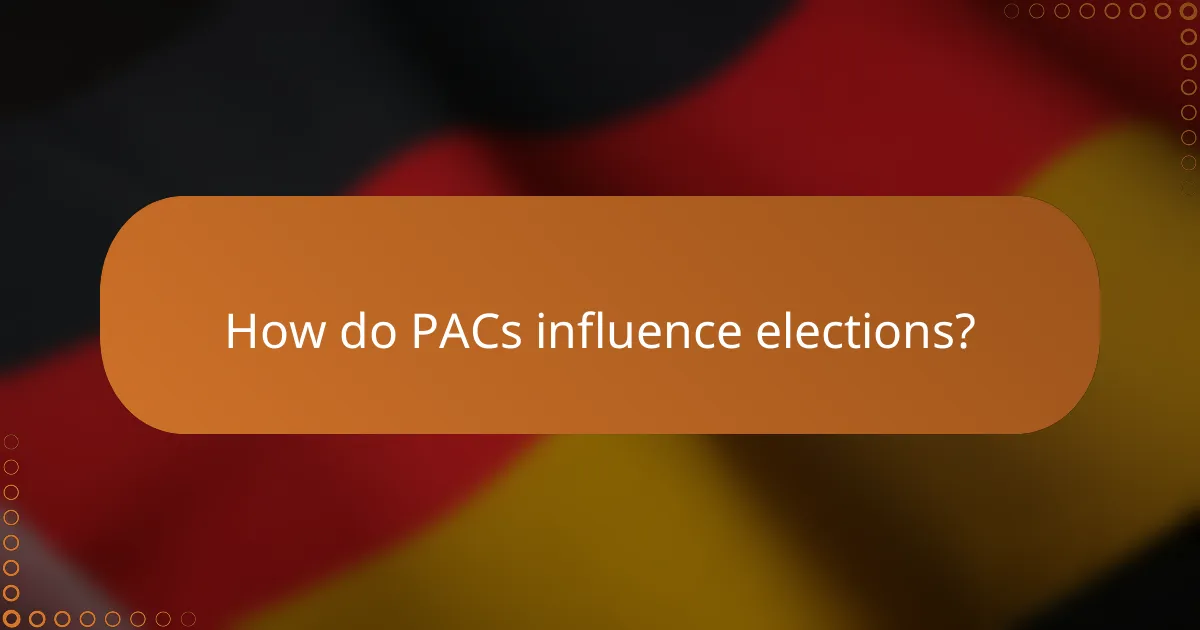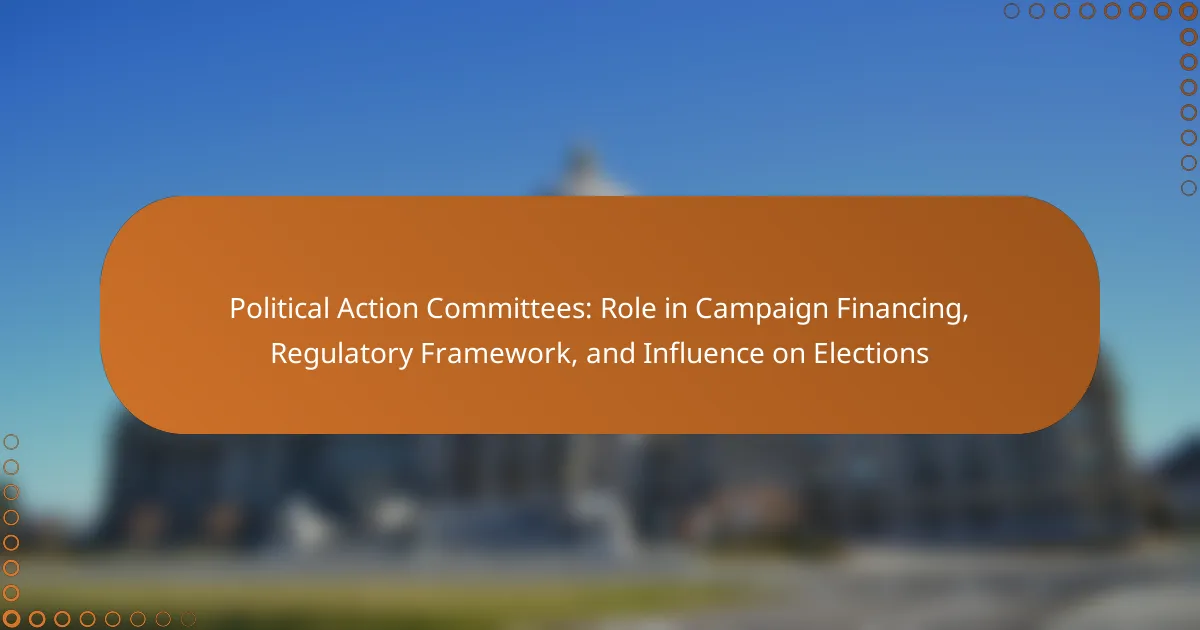Political Action Committees (PACs) are organizations that raise and spend money to influence the election of political candidates. Regulated by the Federal Election Commission (FEC) and governed by laws such as the Federal Election Campaign Act (FECA) and the Bipartisan Campaign Reform Act (BCRA), PACs must adhere to specific contribution limits and reporting requirements. In the 2020 election cycle, PACs contributed over $1.5 billion to federal candidates, demonstrating their significant role in campaign financing. This article explores the regulatory framework surrounding PACs, their methods of influencing elections, and the impact they have on electoral outcomes and policy directions.

What are Political Action Committees (PACs)?
Political Action Committees (PACs) are organizations that raise and spend money to elect or defeat political candidates. PACs collect contributions from members and donate them to candidates or political parties. They are regulated under federal and state laws. The Federal Election Commission (FEC) oversees their activities at the federal level. PACs can be formed by corporations, labor unions, or other interest groups. They play a significant role in campaign financing, influencing elections through financial support. In 2020, PACs contributed over $1.5 billion to federal candidates. This demonstrates their impact on the political landscape.
How do PACs function within the political landscape?
Political Action Committees (PACs) function as organizations that raise and distribute funds to influence political elections and policies. They collect contributions from individuals and organizations to support candidates aligned with their interests. PACs can donate directly to candidates’ campaigns and engage in independent expenditures for advertising. In the United States, PACs are regulated by the Federal Election Commission (FEC), which sets limits on contributions. For example, a PAC can contribute up to $5,000 per election to a candidate. In 2020, PACs contributed over $1.5 billion to federal candidates, highlighting their significant role in campaign financing. They also mobilize grassroots support and can shape public opinion through issue advocacy. Overall, PACs are integral to the political landscape, enabling organized financial support for candidates and influencing legislative agendas.
What are the primary types of PACs?
The primary types of Political Action Committees (PACs) are connected to their funding sources and purposes. The two main categories are connected PACs and non-connected PACs. Connected PACs are affiliated with a corporation, labor union, or membership organization. They can only solicit contributions from individuals associated with the entity. Non-connected PACs operate independently and can raise funds from the general public. They often focus on specific political issues or candidates. Additionally, there are hybrid PACs that combine characteristics of both connected and non-connected PACs. These classifications impact their regulatory requirements and fundraising strategies.
How do PACs differ from other political entities?
Political Action Committees (PACs) are distinct from other political entities primarily in their purpose and function. PACs are designed to raise and distribute funds to support political candidates and influence legislation. Unlike political parties, which have broader platforms and seek to win elections, PACs focus specifically on financial contributions. Additionally, PACs can be formed by corporations, labor unions, or other organizations, allowing them to pool resources for political influence.
PACs are regulated by laws that limit the amount of money they can contribute to candidates. For example, federal law caps contributions from PACs to individual candidates at $5,000 per election. This regulatory framework sets PACs apart from super PACs, which can raise unlimited funds but cannot directly contribute to candidates. The unique structure and funding limitations of PACs create a specific role within the political landscape, emphasizing financial support over broader political agendas.
Why are PACs important in campaign financing?
PACs, or Political Action Committees, are crucial in campaign financing because they aggregate contributions to support political candidates and causes. They enable individuals and organizations to pool resources, amplifying their political influence. In the 2020 election cycle, PACs contributed over $1.5 billion to candidates and parties. This financial support helps candidates cover campaign expenses such as advertising and outreach. Furthermore, PACs can mobilize voters and shape public opinion through targeted campaigns. Their ability to raise significant funds allows them to impact election outcomes, making them a vital component of the political landscape.
What role do PACs play in funding political candidates?
Political Action Committees (PACs) play a significant role in funding political candidates. PACs are organizations that collect and distribute contributions to candidates for political office. They can support candidates who align with their interests and agendas. PACs are subject to regulations that limit the amount of money they can contribute directly to candidates. For example, in the United States, federal law allows PACs to contribute up to $5,000 per candidate per election. In 2020, PACs contributed over $1.5 billion to candidates, highlighting their financial influence in elections. This funding can help candidates promote their campaigns and reach voters effectively.
How do PAC contributions influence election outcomes?
PAC contributions significantly influence election outcomes by providing financial support to candidates. This financial backing allows candidates to amplify their campaigns through advertising and outreach efforts. Candidates with substantial PAC contributions often have increased visibility and voter engagement.
Research shows that candidates receiving PAC funding are more likely to win elections. For instance, a study by the Center for Responsive Politics found that in 2018, candidates who received PAC contributions had a win rate of 85%.
Furthermore, PACs may align their contributions with specific issues, swaying candidates to support particular policies. This alignment can lead to legislative outcomes that reflect the interests of the PACs. Overall, PAC contributions play a critical role in shaping both electoral results and policy decisions.

What is the regulatory framework governing PACs?
The regulatory framework governing Political Action Committees (PACs) is primarily established by the Federal Election Commission (FEC). PACs must register with the FEC and adhere to specific contribution limits and reporting requirements. The Federal Election Campaign Act (FECA) outlines these regulations. FECA sets limits on the amount individuals can contribute to PACs. It also mandates regular financial disclosures, ensuring transparency in campaign financing. Additionally, the Bipartisan Campaign Reform Act (BCRA) further regulates PAC activities and soft money contributions. These laws collectively ensure accountability and limit undue influence in elections.
How are PACs regulated at the federal level?
Political Action Committees (PACs) are regulated at the federal level by the Federal Election Commission (FEC). The FEC enforces laws regarding the financing of federal elections. PACs must register with the FEC and disclose their financial activities. They are subject to contribution limits and expenditure restrictions. For instance, PACs can contribute a maximum of $5,000 to a candidate per election. Additionally, they must report their contributions and expenditures regularly. This regulatory framework ensures transparency and accountability in campaign financing.
What are the key laws affecting PAC operations?
The key laws affecting PAC operations include the Federal Election Campaign Act (FECA), the Bipartisan Campaign Reform Act (BCRA), and the Supreme Court’s Citizens United v. FEC decision. FECA establishes the framework for campaign finance regulation and requires PACs to disclose their contributions and expenditures. BCRA, enacted in 2002, aimed to regulate the financing of political campaigns and restricts the use of soft money. The Supreme Court’s ruling in Citizens United v. FEC in 2010 allowed corporations and unions to spend unlimited amounts on independent political expenditures. These laws collectively shape how PACs operate, influencing their fundraising and spending practices in elections.
How do these regulations impact PAC contributions?
Regulations significantly impact PAC contributions by imposing limits on donation amounts and requiring transparency in reporting. These limits restrict the total contributions PACs can make to candidates and parties. For instance, federal law caps individual contributions to a PAC at $5,000 per year. Additionally, regulations mandate that PACs disclose their financial activities, enhancing accountability. This transparency allows voters to track where funds are coming from and how they are used. Research indicates that stricter regulations can lead to decreased overall contributions to PACs. Consequently, these regulations shape the financial landscape of political campaigns and influence electoral outcomes.
What are the state-level regulations for PACs?
State-level regulations for Political Action Committees (PACs) vary by state. Each state has its own laws governing the formation, operation, and reporting requirements for PACs. Common regulations include registration with state election offices and regular financial disclosures. Some states impose contribution limits to PACs, while others allow unlimited contributions. Certain states require PACs to disclose their donors, enhancing transparency. Additionally, regulations may differ regarding the types of entities that can contribute to PACs, such as individuals, corporations, and unions. Specific rules can be found in each state’s election code.
How do state laws differ from federal regulations?
State laws differ from federal regulations in their scope and application. State laws govern issues within state boundaries and can vary significantly from one state to another. Federal regulations apply nationwide and create a uniform standard across all states. For example, campaign finance laws can differ widely; some states impose stricter limits on contributions than federal laws. Additionally, states have the authority to regulate the formation and operation of Political Action Committees (PACs) within their jurisdictions. This leads to variations in reporting requirements and contribution limits. The U.S. Constitution grants states the power to legislate on matters not expressly reserved for the federal government, leading to these differences.
What challenges do PACs face in compliance with these laws?
Political Action Committees (PACs) face several challenges in compliance with campaign finance laws. These challenges include navigating complex regulations that vary by state and federal jurisdictions. PACs must accurately report contributions and expenditures, which can be cumbersome and time-consuming. Additionally, they often struggle with transparency requirements, as failure to disclose information can lead to penalties. The evolving nature of campaign finance laws also complicates compliance, as PACs must stay updated on legal changes. Furthermore, limited resources can hinder smaller PACs from effectively managing compliance efforts. Overall, these factors contribute to the difficulties PACs encounter in adhering to legal standards.

How do PACs influence elections?
Political Action Committees (PACs) influence elections by raising and spending money to support candidates. They mobilize resources to advocate for specific political agendas. PACs can contribute directly to candidates’ campaigns within legal limits. They also engage in independent expenditures to promote or oppose candidates. In the 2020 election cycle, PACs spent over $1.5 billion on various campaigns. This financial support can significantly impact a candidate’s visibility and viability. Research indicates that candidates backed by PACs often have increased chances of winning. The influence of PACs shapes electoral outcomes and policy directions.
What strategies do PACs use to sway voter opinions?
Political Action Committees (PACs) use various strategies to sway voter opinions. They often fund advertisements that promote specific candidates or issues. These ads can be targeted to specific demographics to maximize impact. PACs also conduct grassroots mobilization efforts to encourage voter turnout. They organize events, phone banks, and door-to-door canvassing to engage voters directly. Additionally, PACs may leverage social media platforms to spread their messages quickly. They utilize data analytics to understand voter preferences and tailor their strategies accordingly. Research shows that targeted advertising can significantly influence voter behavior. Studies indicate that PAC-funded ads can increase candidate recognition and favorability among voters.
How do PACs leverage media and advertisements?
Political Action Committees (PACs) leverage media and advertisements to influence voter perceptions and mobilize support. They create targeted ad campaigns that highlight specific issues or candidates. These advertisements often utilize various media platforms, including television, radio, and digital channels. PACs aim to reach specific demographics to maximize impact. For instance, they may run ads during peak viewing times to ensure higher visibility. Research shows that political ads can significantly sway voter opinions, especially in competitive races. According to the Pew Research Center, 62% of voters reported that ads influenced their decisions in the 2020 elections. This demonstrates the effectiveness of PACs in shaping electoral outcomes through strategic media use.
What role do grassroots efforts play in PAC influence?
Grassroots efforts significantly enhance the influence of Political Action Committees (PACs). They mobilize local communities to advocate for specific issues or candidates. This grassroots support can amplify the reach of PAC messaging. It creates a network of engaged voters who can sway public opinion. Studies show that grassroots campaigns can increase voter turnout by up to 20%. This engagement can lead to greater financial contributions to PACs. Additionally, grassroots efforts often provide valuable data on voter preferences. This information can help PACs tailor their strategies effectively. Overall, grassroots initiatives are crucial for maximizing PAC impact in elections.
What are the potential downsides of PAC influence in politics?
PAC influence in politics can lead to several potential downsides. One major downside is the disproportionate influence of wealthy donors. This can skew political priorities toward the interests of a few rather than the general public. Another issue is the potential for corruption or the appearance of corruption. When PACs fund campaigns, they may expect favorable legislation in return. This creates a conflict of interest for elected officials. Additionally, PACs can contribute to political polarization. They often support extreme candidates, reducing the chances for moderate voices. Research shows that increased PAC spending correlates with decreased voter trust in government. This undermines the democratic process. Overall, PAC influence can compromise the integrity of political systems and diminish public engagement.
How can PACs contribute to political polarization?
Political Action Committees (PACs) contribute to political polarization by funding candidates who align with specific ideological views. This financial support often encourages candidates to adopt more extreme positions to secure funding. As a result, candidates may cater to the preferences of their contributors rather than their constituents. This focus on ideological alignment can deepen divisions between political parties. Studies indicate that increased PAC spending correlates with heightened partisan conflict. For example, data from the Center for Responsive Politics shows that PAC contributions have surged in recent elections, amplifying partisan messaging. Consequently, the role of PACs in elections can lead to a more polarized political landscape.
What are the ethical concerns surrounding PAC activities?
Ethical concerns surrounding PAC activities include potential corruption and undue influence on political processes. PACs can contribute large sums of money to candidates, leading to perceptions of favoritism. This financial power may skew political priorities towards the interests of wealthy donors. Transparency issues arise when the sources of PAC funding are obscured. Voter trust can diminish if citizens believe their representatives are beholden to special interests. Additionally, the lack of limits on PAC contributions can exacerbate inequality in political representation. Studies show that increased PAC spending correlates with heightened legislative influence, raising questions about the integrity of democratic processes.
What best practices should PACs follow for effective engagement?
Political Action Committees (PACs) should prioritize transparency and compliance with regulations for effective engagement. Transparency builds trust with stakeholders and the public. Compliance ensures PACs operate within legal frameworks, avoiding penalties. Regularly updating stakeholders on activities fosters ongoing support. Engaging in grassroots efforts can amplify their message and reach. Utilizing data analytics helps tailor communication strategies to target audiences. Collaborating with like-minded organizations enhances influence and effectiveness. Continuous evaluation of engagement strategies ensures adaptability to changing political landscapes. These practices collectively strengthen PACs’ impact on campaigns and elections.
Political Action Committees (PACs) are organizations that raise and spend money to influence political elections and policies. This article examines the role of PACs in campaign financing, detailing their functions, types, and how they differ from other political entities. It also explores the regulatory framework governing PACs, including federal and state regulations, and the challenges they face in compliance. Additionally, the article discusses the influence of PAC contributions on election outcomes and the potential downsides of their activities, such as political polarization and ethical concerns. Best practices for PAC engagement are also highlighted to enhance their effectiveness in the political landscape.
